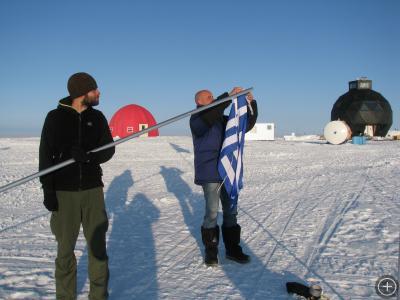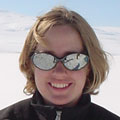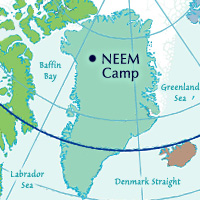Hello from NEEM!
NEEM CAMP, GREENLAND– Hello from NEEM! After yesterday’s Herc (Herc’s are the ski-equipped C-130 aircraft that we fly on in Greenland and in Antarctica. They are flown by members of the 109th division of the Air National Guard.) flight from Kangerlussuaq on the coast to the NEEM drilling camp on the Greenland ice sheet in which we circled camp several times but were not able to land due to thick ground fog (and diminishing fuel!), today we were able to land today at camp. Finally. It did mean that we were woken up rather abruptly and unexpectedly early this morning since the weather up at camp was good, and they wanted to try to give us the best possible chance of landing this time. I was woken up with a knock on the door at 7am and told that they wanted us at the runway in 15 minutes. Such is fieldwork in remote locations! It’s always best to just roll with the punches.
We are getting up to camp in the middle of a very successful season, so far, for the deep drilling campaign being lead by Danish researchers from the Niels Bohr Institute in Copenhagen. The project I am working on is a side project, really. We’ll be working 2 km (1.2 miles) away from the main drilling camp on a “shallow” drilling project. Shallow in this case is to the transition from snow to ice, which we expect to happen around 80 m (260 ft) here. At this depth, the weight of the snow layers above is enough to compress the snow, which is open to air flow with large spaces between snow particles, into ice, in which air pockets become isolated from one another. As we drill, several groups will be sampling the air in the borehole at different depths. My main job in this group is to log the core that we are drilling, which will later be shipped back to the lab for measurements of permeability (how easily air can be pumped through the snow) and grain size. Luckily, I won’t be making these measurements! Kaitlin Keegan, a new PhD student at Dartmouth College, will. She’s up with me at NEEM to get a first-hand view of how this all works. My other main job is to dig and sample a 2 m (6.5 ft) deep snow pit. Pits are dug in the top 2 m because usually cores from the surface are too fragile to make it back to the lab intact. Below that though, the cores are usually surprising robust…a bit like Styrofoam.
NEEM is a mini, frozen United Nations on the ice cap. Flags are flown for every country represented at camp, and they are many. One of the first orders of business is to fly the Greek flag, in honor of Vasileois Gnikos, a Greek native working in Denmark on his PhD thesis who arrived on the same plane that I did.

 No comments
No comments 









